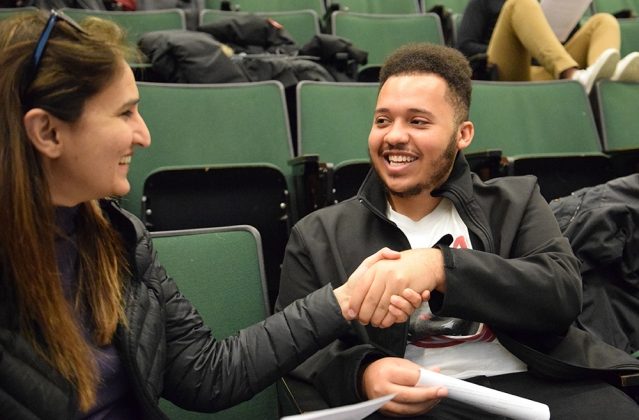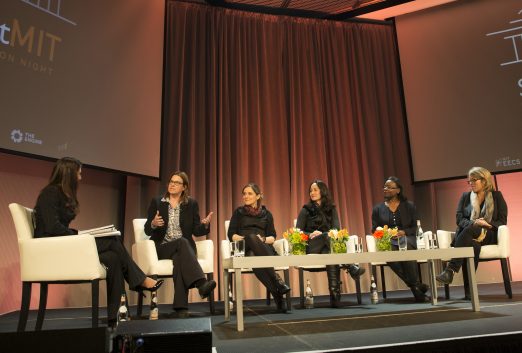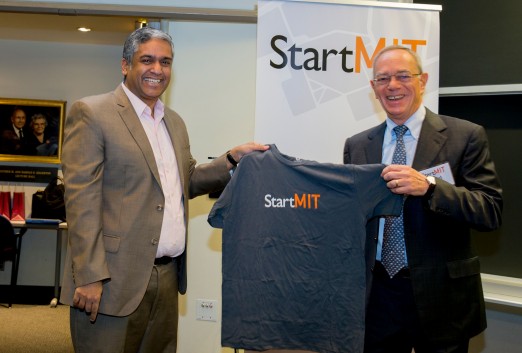Alison F. Takemura | Department of Electrical Engineering and Computer Science
February 7, 2017
If you daydream about founding a startup, know this: CEOs are made, not born. Theodora Koullias ’13 — founder of the tech-fashion company Jon Luu — explained on Jan. 17 to a group of students and postdocs what it’s really like. “You learn on the job all the time.”
Koullias candidly shared her experience as part of StartMIT, a course packed with practical instruction and mentorship, designed to give aspiring entrepreneurs a boost up the founder learning curve. Held Jan. 9-23 during MIT’s Independent Activities Period, StartMIT gave participants a chance to form teams and develop their ideas into venture capital-worthy pitches. Students learn about the smorgasbord of ingredients that go into making a startup: creating a value proposition, staking a claim to intellectual property, working with the press, networking, creating culture, and, of course, raising money.
“StartMIT featured some amazing speakers who engaged actively with our students on all aspects of starting a company, giving them a glimpse of what an entrepreneurship career is,” says StartMIT lead organizer and Department of Electrical Engineering and Computer Science (EECS) head Anantha Chandrakasan, the Vannevar Bush Professor of Electrical Engineering and Computer Science. The course was developed by EECS and supported by the MIT Innovation Initiative.
Hello, world
Scientists and engineers often find themselves wanting to turn their research into a product, says invited speaker Institute Professor Robert Langer. “We want to see it get out to the world and help people.”
But founders need grit. The most defining characteristic of students that have become successful business leaders, says Langer, who holds more than a thousand pending and issued patents, is a willingness “to walk through walls to get their technology out into the world.”
Ray Stata ’57, co-founder of Analog Devices, Inc. and leader in the design and manufacture of analog and digital signal processing semiconductors, didn’t sugar-coat the entrepreneur’s brand of determination. “When you start a company, there is no work-life balance,” he told students. “You continue to drink from the fire hose not only because you have to but because you are so committed and motivated to succeed.”
Wen Jie Ong, a graduate student in chemistry, is determined to get his innovation to the public because he sees his technology’s relevance. He’s been developing a polymer that removes lead from contaminated water, making it safe to drink. To underscore the need, Ong points to the recent Flint water crisis — in which the city’s 100,000 residents have had to grapple with lead, a neurotoxin, in their drinking water — but also to examples that are closer to home. In November 2016, drinking water at 164 schools in Massachusetts had lead levels above regulatory limits.
StartMIT, Ong says, “is a large time commitment, but it’s totally worth it.” The course exposed him to new ideas through its star speakers, and put him in touch with mentors, including venture capitalists, who gave him “very frank” advice, he adds. He couldn’t have gotten that anywhere else.
Keeping it real
Direct feedback is priceless, says Susan Hockfield, who served as president of MIT from 2004 to 2012. She told the class a story about how at her very first poster presentation as a graduate student, she hadn’t known people would actually want to talk with her about her work. So, unprepared, she rambled. Afterward, she spoke to her advisor standing nearby, “I really felt stupid over there,” she said. His response? “Yeah, you sounded pretty stupid.”
Hockfield appreciated that unfettered honesty. She encouraged the audience, “Find someone who’s willing to tell you as it really is.”
Lyric Jain hopes to make the media we consume every day into a similarly unbiased resource. “Polarization in the media is a big problem,” says the Cambridge University-MIT exchange student in mechanical engineering during one of the course’s networking lunches.
To broaden readers’ perspectives, Jain is working on a web platform that delivers news from across the liberal-conservative political spectrum of media outlets: from MSNBC to Fox News. Not only that, his technology will automatically prune the stories to their facts, lining them up for readers as different sides of a debate.
It’s still early in his project, Jain says, and he started the course guarded. “Initially, I was quite suspicious that if I talk to someone, they’re going to steal my idea,” he says. “But now I know the idea is only one small part of it. What matters is how you build on the idea, put your twist on it, and build a team around it,” he says.
Besides, there are pluses to being open. “Talking to people about your idea, you’re going to get input to make it better.” He adds with a smile: “They might even be a potential customer.”
Of mentors and role models
Rabia Yazicigil has noted the risk posed by devices that communicate with each other — components of the so-called internet of things (IoT). A hacked pacemaker, for example, could be a potential murder weapon. To prevent that gruesome possibility, Yazicigil is developing a new kind of secure wireless communications system for IoT devices.
Before StartMIT, Yazicigil had some reservations about starting a company. Hearing from scientists who became business leaders — including Hockfield; Langer; Stata; and Michael Stonebraker, adjunct professor of computer science at MIT and co-director of Intel Science and Technology Center — helped Yazicigil see a path for herself.
“I want to stay in academia more than become an entrepreneur,” says the EECS postdoc. “But I see how they’re able to still do both at the same time.”
Dozens of other pioneers also shared their experiences during the course, including emphasizing the importance of communicating, building trust with your funders, and assembling an excellent team.
In addition, StartMIT allowed students to explore the entrepreneurial ecosystem beyond MIT. Students took field trips to Ministry of Supply, an innovative fashion company founded by MIT alumni; venture capital firms Pillar VC, Bolt, and Project 11 Ventures; the non-profit startup accelerator MassChallenge; and the Cambridge Innovation Center, which houses a number of MIT startups.
The Institute has a wealth of opportunities as well to support student ventures. Several teams will be utilizing MIT’s Venture Mentoring Service and have applied to MIT’s Sandbox Innovation Fund for both funding and matched mentors.
One of the StartMIT teams hoping for a spot in the Sandbox this year is tackling the problem of medicine adherence: Rex. The team is a group of six women — three of whom took the course — developing an app for children that gamifies taking their prescribed medication.
“Our goal is really to help reduce the stress for families of children who have chronic conditions,” says Rex member and MIT senior Anna Fountain.
Part of what makes StartMIT so useful are the interpersonal connections, says Fountain, a student in mechanical engineering. “It makes me feel a lot more comfortable knowing that there are people who can help us and who have done this before — right here in the greater MIT community.”
Reprinted with permission of MIT News.



